“You see that? That’s bad.”
Bernard Arghiere pulls his SUV off Swannanoa River Road in Asheville and gestures toward a nearby bridge. After spanning the river, it touches down on the acres of pavement surrounding the Wal-Mart Supercenter.
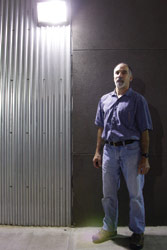
The asphalt, the store and its deeply discounted contents are of little interest to Arghiere, though. What he’s mad about are the lights.
“That row of lights on that bridge,” he says. “They call those ‘acorn lights.’ Look at them: Look at how many there are. Look at how bright they are.”
It’s dusk, and some might find the arc of pinkish lights along the bridge cheering—something that wouldn’t look out of place in an impressionist painting. But today’s world, Arghiere maintains, is “overlit,” and despite their quaintness, fixtures like these are prime culprits. Their transparent glass domes spill light in every direction. Their bulbs burn from dusk to dawn—and sometimes, due to faulty sensors, all day long.
“Progress Energy sells these lights to their customers and claims that the customers like the look of them,” says Arghiere. “Well, they might look fine during the day, but after dark they’re a nightmare.”
To ride around Asheville with Arghiere is to learn a new language: “trespass,” the drift of light from where it’s wanted to where it’s not; “foot-candle,” a unit measuring the light falling on a given surface; “wall packs,” the enclosed metal boxes that light the sides of many commercial buildings; “full cutoff,” a fixture whose light travels only downward, not off to the sides; and “sag,” when a light’s glass enclosure dips below the fixture’s bottom surface.
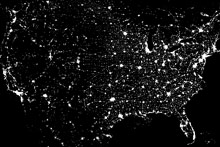
To ride with Arghiere is also to become maddeningly aware of how much energy is consumed putting light where it doesn’t necessarily belong—and the unintended effects.
“When I moved to east Asheville 12 years ago, I could look up at night and see the Milky Way,” he says. “Now I can see it only occasionally—and then only because I know where to look.” Arghiere is an amateur astronomer, and to some extent his interest in preserving the night sky is self-serving: The more we light it, the more the universe retreats. Saturn’s rings wilt before the Quick Stop’s glare.
Aesthetic considerations aside, excessive outdoor lighting has only recently begun attracting scrutiny. But since science began assessing the practice’s consequences in the 1990s, the rap sheet against it has grown. Improperly shielded lights confuse animals, including migrating birds and deer. Insects are fatally attracted to night lighting and die in droves. Along the Southeastern coast, newly hatched sea turtles routinely perish because they’re biologically wired to head toward the brightest spot on the horizon, which up to the 20th century was the moonlit sea. Their confusion makes them more vulnerable to predators such as raccoons and cats, not to mention passing vehicles.
There’s also evidence that excessive outdoor lighting may disrupt human sleep patterns by reducing the body’s melatonin production. And according to at least one recent study, females whose bodies are deprived of the hormone by ambient light may be more vulnerable to breast cancer.
Feeling moved to act on his concerns, Arghiere joined the focus group helping amend the city’s lighting rules. Approved in 2002, those rules closely followed Raleigh’s standards. Now, however, the rules are being revised.
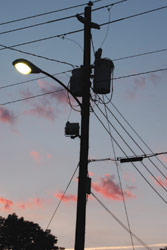
“Some standards need to be looked at more frequently than others,” interim Planning Director Shannon Tuch explains. “In the case of lighting, this happens to be a very technical industry. We’ve seen a lot of rapid changes because of a shift in energy efficiency and a growing concern about light intrusion.” The revised rules, she says, are slated to go before the Planning and Zoning Commission later this summer, and then to City Council.
Changing the status quo
The fix is easy, Arghiere maintains. By replacing wasteful “sag” fixtures, banning floodlights that face up or out, and insisting that nondirectional lights be replaced with full-cutoff fixtures, we “would see a profound difference in the quality of the night sky,” he says.
At present, however, few people even think there’s a problem. And a very persuasive entity, Arghiere argues, is determined to maintain the status quo.
That entity is Progress Energy, which leases street and security lighting to much of the state and sells the power to run those fixtures. Robert Henderson, a lighting specialist with the Raleigh-based utility, also serves on Asheville’s lighting focus group. And while Arghiere concedes that Henderson brings “a lot of technical know-how and expertise” to the table, “He’s also protecting Progress Energy’s light fixtures—and the ones they sell the most are the ones that create the most light pollution,” Arghiere asserts.
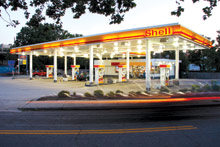
Henderson, however, paints a somewhat different picture. “We were one of the first utilities in the country to go with a full cutoff for street lighting, both in Florida and the Carolinas,” he points out. “So to say that we haven’t moved in that direction, that’s not totally accurate.”
Progress Energy, says Henderson, “is very interested in the environmental aspect of lighting for our customers. But our approach is more of, ‘Well, let’s do a good job of that, but let’s also consider the safety and security needs of citizens and property.
And while progressive lighting designs such as full-cutoff fixtures are good for many situations, says Henderson, they also have their downside. “Because the light is highly directional, you have to put poles closer together,” he explains. “If you don’t put in more lights, you’ve got dark spots between poles. And that’s also where you get into some safety and security issues.”
More poles also means more expense. And because the lights are less readily available in what he calls “utility grade,” full-cutoff fixtures cost more: at least $7 more per lamp.
“We have to look out for the [customer’s] pocketbook,” notes Henderson.
The International Dark-Sky Association aims to reform outdoor-lighting practices both in the United States and abroad. Headquartered in Tuscon, Ariz., the nonprofit stresses the wastefulness of polluting light fixtures, as well as their harmful effects on human health and wildlife. Arghiere is one of the IDA’s more than 11,000 members.
Henderson says he respects the group’s mission, but he believes it doesn’t give a complete picture of the situation. “Their main objective—and they’ll tell you this—is to protect the nighttime sky,” he says. “They really don’t have any particular interest in safety and security: They want to protect the sky so they can look at it.”
Burn, baby, burn
Meanwhile, at least one local municipality has taken a strong stand against light pollution. In May, the town of Woodfin approved a stringent new set of rules for outdoor lighting requiring, among other things, that all streetlights use fully shielded fixtures, that canopy lighting such as that used at gas stations be flush-mounted, and that floodlighting must be directed downward.
James Eller, Woodfin’s code-enforcement officer, says the town was approached by residents concerned about Asheville’s growing light pollution. Because Woodfin is in the midst of creating an entire downtown from scratch, says Eller, this was a good time to act.
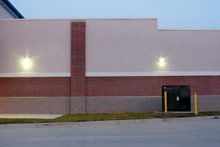
“We were in a position where we could do this out front,” he says. “These rules can be implemented before construction, through the permitting process.”
“Our Board of Aldermen was very interested in reducing light pollution and preserving the nighttime sky,” he continues. “Everyone likes to be able to look out and see the stars.”
Asheville’s proposed new lighting rules also aim to place further controls on outdoor lighting. New “sag” streetlights would be banned, but the thousands of them already in use in the city would be grandfathered. “As their ballasts burn out, they’ll have to be replaced,” Arghiere explains. But since ballasts can last up to 20 years, he says, it could be a slow process.
Rising energy costs are an obvious factor in changing outdoor-lighting practices. Newer technologies such as LED lights, which cost substantially more but are as much as 50 percent more efficient—and longer lasting—than typical sodium vapor streetlights, are one direction municipalities are looking. Through a manufacturer-sponsored program called LED City, Ann Arbor, Mich., has made plans to switch all of its streetlights to LED fixtures and expects to save $100,000 a year on utility costs, with a four-year payback on the investment. Raleigh, too, is considering a switch.
“We’re just beginning pilot programs with LEDs now,” says Henderson of Progress Energy. Because of their high cost, “they’re not an immediate solution,” he says, “but several years down the road, we’ll certainly be looking at them more and more.” Because they produce a more focused beam and tend to have shielded fixtures, he explains, LED lights may help combat light pollution.
Arghiere, however, contends that the practice of “overlighting” the night sky “is a huge energy problem.” Nationwide, unnecessary outdoor lighting wastes millions of dollars annually, estimates suggest.
“Look at our interstate system, for instance,” says Arghiere. “At night, along many stretches, there’s no one driving. And if you are driving, you’ve got headlights. But yet we light whole sections of the road with pole lights. Everybody’s talking new sources of oil, but nobody’s talking about how we can use less energy.”
Arghiere stops his vehicle again, this time close to downtown Asheville. He points to a Shell station across the way, whose piercing white lights make a mockery of the adequately lit Exxon across the street.
“Now that’s an example of some really bad vehicle-canopy lighting,” says Arghiere. “See how it drops down? It’s too much, too many, too bright.
“Geez,” he adds, before driving on, “You could do surgery under there.”



Bravo Woodfin! Keep up the good work!
Thanks for the article, Kent, and thanks for the work, Mr. Arghiere! When I lived in downtown Asheville, I often had trouble sleeping because of all the ambient light (I couldn’t afford drapes big enough for my huge historically-correct windows, or heavy enough to block out enough light).
The energy company representative keeps harping on “safety and security”, as though there were a connection between outdoor lighting and crime rates. There is indeed. Statistics reliably show that bright outdoor lighting results in an increase of nocturnal crime. This flies in the face of the common fear of the dark and appears counterintuitive, but makes perfect sense. Criminals need to see what they’re doing too. They are rarely skulking around in darkness guided by flashlight beams. The great majority of burglaries take place during the day. Most car break-ins happen to vehicles parked beneath or near lights. Lighting up your home or business makes it more apparent to crooks, easier to case. Look out your window at night. What would be more obvious to you, someone prowling in real darkness with a flashlight, or someone lurking in the glare and harsh shadows produced by “security” lighting? This is just another case of our irrational, atavistic fears costing us all a lot and offering very little in return.
Joe, I think just the way you do about this. I have a dog to let me know if someone is skulking about. I have a letter to the editor on this subject in this week’s issue. I saw your comment just now when I was looking up my letter. Didn’t know about making comments online.
I applaud anyone who is doing something about this issue. For years, I have deplored those silly night-lights that rural people put up. I’ve almost always lived out in the country–one of the things I love about it is the darkness at night!–and too many people have dusk-to-dawn lights. The ones I truly hate are the ones that shine in my windows at night and the ones that currently mar the mountain views at night. I would be willing to join any movement to help change this. Please keep me informed as to what I can do (short of shooting them out! LOL).
Bernie Arghiere: Thank you very much for your work to decrease the excess lighting in Asheville.
It is discouraging to have to say “once,in another country,long ago and far away,I could really see the stars!”
Sarah Jane Thomas